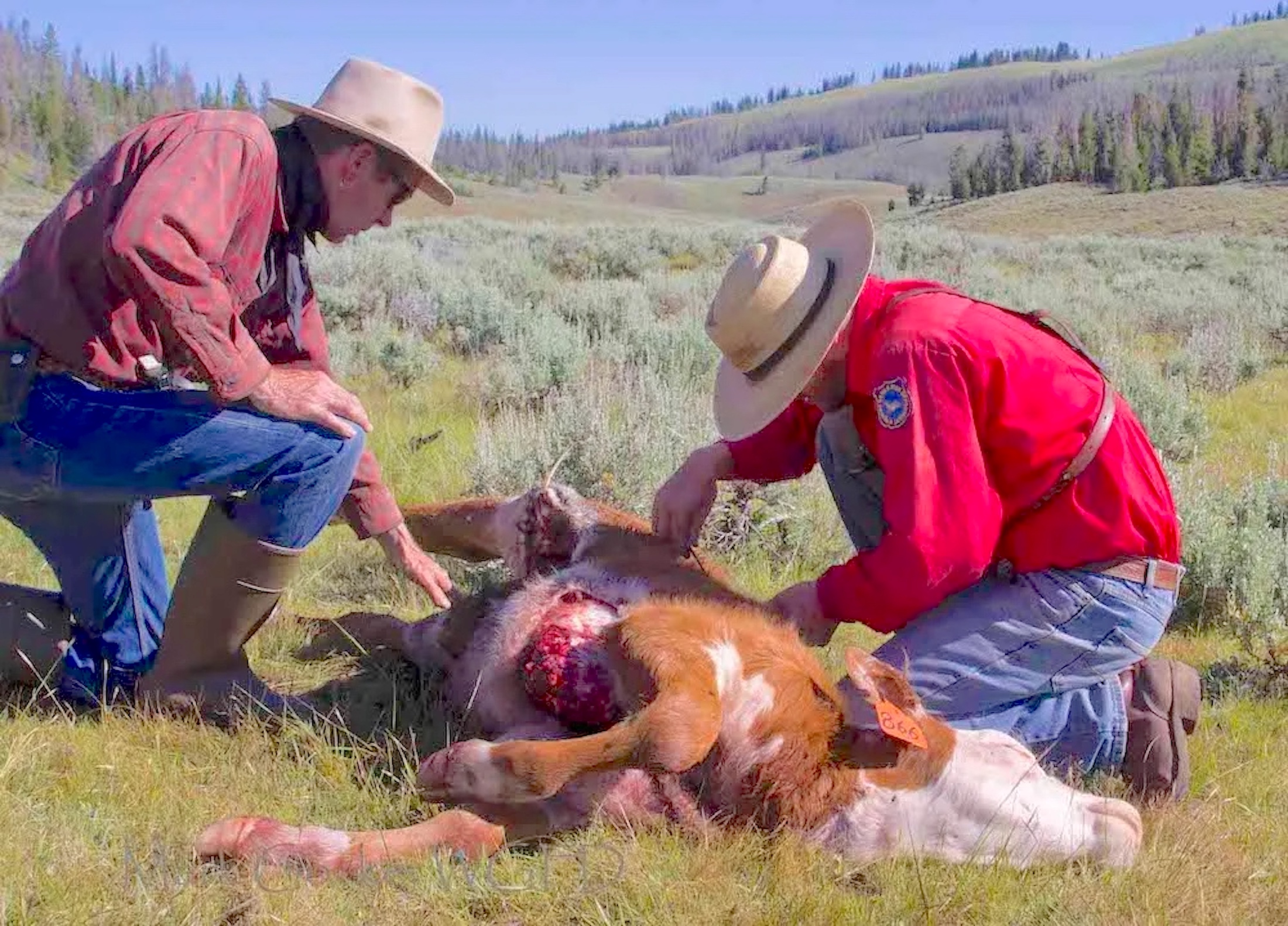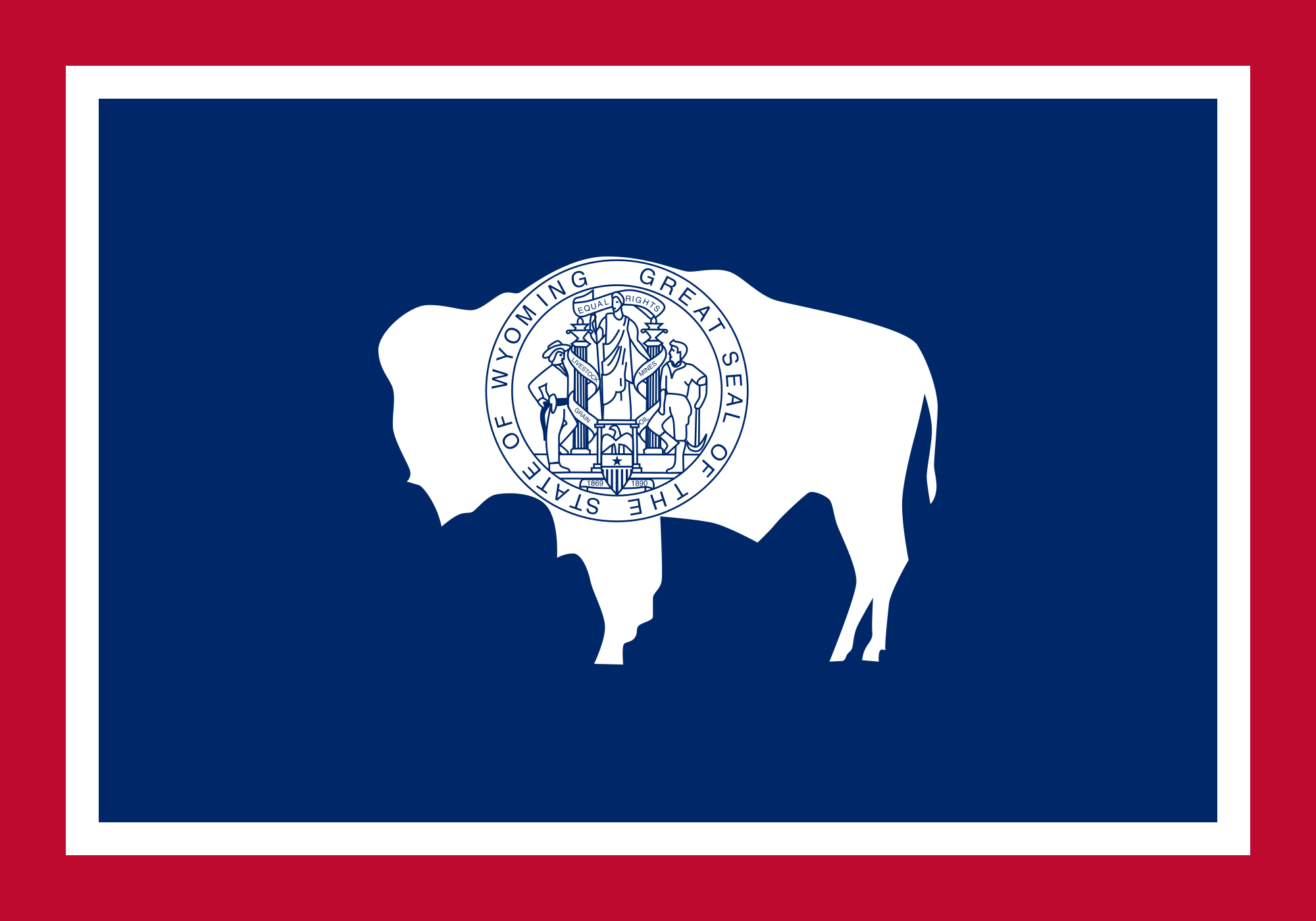Grizzlies killed record high number of cattle in Wyoming, 2024 data shows
By Wyoming News Exchange
March 27, 2025

Wyoming Game and Fish Department Large Carnivore Biologist Zach Turnbull determines the cause of death on a calf in 2014 as range rider/cowboy Todd Stearns looks on. (Mark Gocke/Wyoming Game and Fish Department)
• Despite some experimental attempts to reduce depredation, state biologists report that last year was riddled with strife, especially between bears and domestic livestock in the Upper Green rangeland complex.
By Mike Koshmrl, WyoFile.com
Every year is a conflict-prone year for the scores of cattle and grizzly bears that mix annually on Union Pass, but Coke Landers was especially glad to put 2024 behind him.
The run-ins started shortly after the historic Green River Drift delivered many thousands of cattle to the national forest to fatten up over the summer. By the time ranchers herded the domestic bovids off the vast 267-square-mile Upper Green River grazing allotment on the Bridger-Teton National Forest in the fall, some 94 head of cattle were confirmed to have been killed by large carnivores, he said.
“Ninety-one of them were bears and three were wolves,” said Landers, who took the reins of the Upper Green River Cattlemen’s Association from former president Albert Sommers a few years ago.
“That was the highest ever,” Landers said. “It was a record.”
That’s especially notable considering that the Upper Green has been the Greater Yellowstone Ecosystem’s epicenter of grizzly-cattle conflict over the last couple of decades. It’s also been the site of a not-yet completely resolved legal battle about that conflict, stemming from a federal assessment that OK’d killing up to 72 Endangered Species Act-protected grizzlies due to cattle grazing on public land.
Across grizzly range in the Equality State, it was a tough year for not only bruins killing cattle but for conflict generally. Grizzlies, in turn, were killed at record rates.
The phenomenon was partially explained by the dry year, which 2024 certainly was: More than 800,000 acres in Wyoming burned. The result is desiccated vegetation and sparse berry crops that send the adaptable omnivores looking for alternative food sources. Oftentimes, they end up finding trouble instead.
Wyoming Game and Fish Department officials ran through the numbers and nature of the conflicts during their commission meeting last week in Cody.
“They’re occurring on private lands, the majority of these conflicts,” said Brian Debolt, the large carnivore conflict coordinator for Game and Fish.
Grizzly bears have stopped expanding their range in the Greater Yellowstone Ecosystem, federal biologists say. Nevertheless, much of where they occur today is outside of what Wyoming officials believe to be “suitable habitat.”
“The amount of private land occupied by grizzly bears in the Yellowstone ecosystem — outside of suitable habitat — is bigger than the area of New Jersey,” Debolt said. “Frankly, I get frustrated.”
A graph Debolt presented showed that upwards of 60% of all verified grizzly conflicts in 2024 occurred on private property.
Another graph broke down the cause of the conflict. Cattle dominated with 188 of 242 — a whopping 78% — of all confirmed Wyoming grizzly bear conflicts attributed to domestic bovids in 2024. In order, the next largest conflict sources were pet food, livestock feed and birdseed (13 conflicts) and property damage (11 conflicts).
Grizzlies also killed a record number of Wyoming cattle, Game and Fish Large Carnivore Supervisor Dan Thompson told WyoFile.
“It’s definitely our highest level of conflict,” Thompson said. “There’s this notion that nobody’s doing anything about it. That’s not true. Those producers are doing as much as they can to reduce that conflict potential — as are we.”
About half of Wyoming’s grizzly depredations in 2024 occurred in the Upper Green. Four grizzlies there were captured and killed in response, Thompson said.
There’s been mixed results from efforts to stem the grizzly bear-cattle bloodshed on the massive Bridger-Teton National Forest allotment. Nearly a decade ago, range riders attempted an experimental herding technique to keep cattle bunched up and less vulnerable.
“The herding actually made the kills worse,” Landers said.
More recently, the Upper Green River Cattlemen’s Association tested out motion-triggered LED lights known as “flasher tags” that were fastened to calves’ ears.
“I put 250 in, and I didn’t have any calves killed with a flasher tag that year,” Landers said. “But when I pulled the flasher tags in the fall, of the 250, there were only 10 of them that were still working.”
Wyoming secured, but then lost, a federal grant that was going to allow Upper Green cattlemen to scale up the effort with more durable flasher tags, according to Thompson. He didn’t specify exactly what happened to the grant, which went away during a period of extreme turmoil for the federal workforce and grants provided by the federal government under the Trump administration.
“There’s a lot of unknowns right now, let’s put it that way,” Thompson said. “But we still figured out a way to do a pilot component to look at some of these things. We’re still moving forward.”
A new prototype of the tags, Landers said, went out on 14 calves during the 2024 grazing season.
“One of my calves with a flasher tag got killed,” Landers said, “but all of those flasher tags were working when they came home.”
In 2025, they’re going to try another design again, just not in big numbers, he said.
A few months out from the Bridger-Teton grazing season, Landers is encouraged by the relatively big snow year in the region. Snowpack readings in the Upper Green River drainage were sitting at 110% of the long-term median as of Tuesday, but a SNOTEL site up in the allotment was at 127%.
“We should have plenty of moisture and hopefully not as dry of a summer,” Landers said. “A better berry crop does make a difference.”
If an easy conflict year doesn’t come to fruition, the status quo will have to do. Although there’s plenty of carnage, the system is one that the Upper Green River Cattlemen’s Association president says is working.
“The way our cattle association has been living with the bears and the wolves — and with our state’s compensation program — is a pretty good success story,” Landers said. “Honestly, we’re living together. We’re not always getting along, but we’re living together and we’re getting it done.”
Grizzlies in Wyoming and throughout the Lower 48 continue to be managed as “threatened” under the Endangered Species Act. A Biden-era proposal to extend that classification, which precludes grizzly bear hunting, is open to public comments through May 16.
WyoFile is an independent nonprofit news organization focused on Wyoming people, places and policy.

